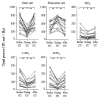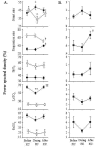Cerebral oxygenation responses during kangaroo care in low birth weight infants
- PMID: 18990243
- PMCID: PMC2585079
- DOI: 10.1186/1471-2431-8-51
Cerebral oxygenation responses during kangaroo care in low birth weight infants
Abstract
Background: Kangaroo care (KC) has been widely using to improve the care of low birth weight infants. However, very little is known about cerebral hemodynamics responses in low birth weight infants during KC intervention. The objective of this study was to elucidate the response of cerebral hemodynamics during KC in low birth weight infants.
Methods: Near infrared spectroscopy measured regional cerebral oxygenation (rSO2), heart rate (HR), respiration rate (RR) measured by electrocardiogram, and percentages of oxygen saturation (SpO2) measured by pulse oxymetry was monitored in 16 preterm infants (< 1600 g) in three sessions: before, during, and after KC. Using power spectral analysis, total power (TP), low-frequency (LF, 0.02-0.20 Hz) and high-frequency (HF, 0.20-0.50 Hz) bands, the ratio of LF/HF were calculated and normalized as %LF or %HF = LF or HF/TP x 100 (%).
Results: Significant differences were not observed in the mean rSO2, HR, and SpO2 throughout sessions; however, the TP of these parameters was significantly decreased during KC and increased after KC (p < 0.001). The %LF of LrSO2 and RrSO2 was decreased during KC (p < 0.05) with decreased %HF in RrSO2 (p < 0.05). The %LF of HR was significantly increased during KC while %HF was decreased (p < 0.05). Mean and TP of RR was increased during KC (p < 0.01 respectively) with the increase of quiet sleep state (p < 0.05) and decreased after KC (p < 0.01). The %LF of RR was increased after KC (p < 0.05) with decreased %HF (p < 0.05); however, significant changes were not observed during KC.
Conclusion: KC intervention appears to have influence on cerebral hemodynamics as well as cardiorespiratory parameters. The results of rSO2 and HR might be associated with quiet sleep states. The results of this study may indicate the contribution of KC intervention to the activation of central nervous system and brain function. Further study is needed to determine the underlying physiology responsible for these differences.
Figures




References
-
- Anderson GC. Current knowledge about skin-to-skin (kangaroo) care for preterm infants. J Perinatol. 1991;11:216–226. - PubMed
Publication types
MeSH terms
Substances
LinkOut - more resources
Full Text Sources
Medical
Research Materials
Miscellaneous

